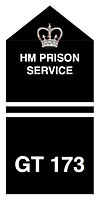His Majesty's Prison Service

Her Majesty's Prison Service is a part of the National Offender Management Service of the Government of the United Kingdom tasked with managing most of the prisons within England and Wales. (Scotland and Northern Ireland have their own prison services: the Scottish Prison Service and the Northern Ireland Prison Service, respectively).
The Director-General of the National Offender Management Service, currently Michael Spurr, is the administrator of the prison service. The Director-General reports to the Secretary of State for Justice and also works closely with the Prisons Minister, a junior ministerial post within the Ministry of Justice.
It has its head office in Clive House. [1] It formerly had its head office in Cleland House in the City of Westminster, London.[2]
Operation
In 2004, the Prison Service was responsible for 130 prisons and employed around 44,000 staff. As of 2009 the number of prisons had increased to 131, including 11 privately owned prisons.[3]
The Service's statement of purpose states "Her Majesty's Prison Service serves the public by keeping in custody those committed by the courts. Our duty is to look after them with humanity and help them lead law-abiding and useful lives in custody and after release." The Ministry of Justice's objective for prisons seeks "Effective execution of the sentences of the courts so as to reduce re-offending and protect the public".
Population statistics for the Service are published weekly. Statistics available for 3 September 2010 showed the service housed 84,955 prisoners: 80,722 males and 4,233 females.[4]
Reform
Early in 2004, it was announced that the Prison Service would be integrated into a new National Offender Management Service later in the year.
Rationalisation of the prison management system is currently underway with the advent of the Titan Prison concept.
Prison officers
Powers
Public sector Prison officers have "all the powers, authority, protection and privileges of a constable" whilst acting as such.[5]
Although the system is flexible in operation, most Prison Officers work in small teams, either assigned to a specific duty, or providing one shift of staff for the supervision of a particular wing within a prison. Each such team is led by a Senior Prison Officer. Where several teams work together, such as the different staff shifts on an individual prison wing, there will be an overall supervisor with the new position of Prison Service Manager (previously the rank of Principal Prison Officer closed in 2010).
All uniformed prison staff were formerly under the supervision of a small number of very senior and experienced officers who held one of three Chief Officer ranks; however, reorganisation in the 1980s termed 'Fresh Start' saw these Chief Officer ranks abolished, and their role taken by junior grade prison Governors. During the recent restructure of 2010 Principal Officers were offered employment as Developing Prison Service Managers (non-uniformed) those that declined this offer remain as Principal Officers however recruitment to this rank has closed.
| Historic rank insignia in use until 1987 | ||||||
|---|---|---|---|---|---|---|
| Rank | Prison Officer | Senior Prison Officer | Principal Prison Officer | Assistant Chief Officer | Chief Officer (Grade II) |
Senior Chief Officer (Grade I) |
| Insignia | 
|

|

|

|

|

|
| Rank insignia from the "A Fresh Start" initiative, 1987–2000 | ||||||
| Rank | Prison Officer | Senior Officer | Principal Officer | |||
| Insignia | 
|

|

|
The Chief Officer grades were abolished and replaced with junior Governor grades. | ||
| Revised rank insignia with LIDS code and unique identification numbers, 2000–2013 | ||||||
| Rank | Operational Support Grade (OSG) | Prison Officer | Senior Officer | Principal Officer | (Specialist Officer) | |
| Insignia |  |
 |
 |

|
Additionally authorised letters could be used to indicate specialist functions: DH - dog handler W - works officer H - healthcare officer | |
| Current rank insignia introduced from April 2013 | ||||||
| Rank | Operational Support Grade (OSG) | Prison Officer | Supervising Officer | Custodial Manager | (Specialist Officer) | |
| Insignia |  |
 |
 |

|
Specialist Officers have role identification letters on their epaulettes: DH - dog handler W - works officer H - healthcare officer | |
Private prisons
The Prison Service does not manage all prisons within England and Wales. Currently there are nine prisons that have been designed, constructed, managed and financed (so-called DCMF prisons) privately. In addition, three prisons that were built with public money are managed by private companies under contract. During 2012 two further prisons will open under private sector management: Belmarsh West, a DCMF prison, and Featherstone 2 prison, built by the public sector. Private prisons are subject to scrutiny by Her Majesty's Chief Inspector of Prisons in a similar manner to prisons run by the public Prison Service.
Proposed legislation
In January, 2008, the Home Secretary announced that the government was to introduce legislation to remove the right for Prison Officers in England and Wales to take strike action.[6]
Independent Monitoring Board
Every prison and immigration removal centre has an Independent Monitoring Board (IMB), formerly known as a Board of Visitors. Members of the IMB, who are volunteers, are appointed by the Home Secretary and act as 'watchdogs' for both the Minister of Prisons and the general public, to ensure that proper standards of care and decency are maintained.[7]
HMPS in the National Offender Management Service
On 6 January 2004, then Home Secretary David Blunkett announced that the Prison Service, together with the National Probation Service, is to be integrated into a new National Offender Management Service. The Service, Blunkett said, will be "a new body to provide end-to-end management of all offenders".
On 1 April 2008, NOMS was reorganised as part of a shake-up in the Ministry of Justice. The headquarters and regional structures of NOMS and HMPS were merged into a single HQ structure with Phil Wheatly as Director General of NOMS. This brings HMPS and the National Probation Service under a single headquarters structure for the first time ever.[8]
On 1 June 2011, NOMS was merged with the wider MoJ (HMCTS etc) to form one organisation. Although HMCTS and NOMS are working under different terms and conditions, they are now managed together and HR is dealt with by one Shared Service centre. A review of terms and conditions for all MoJ staff, including NOMS, is currently in progress with view to bringing all staff terms and conditions across NOMS and HMCTS in line.
See also
Her Majesty's prison service collection is held at the Galleries of Justice Museum in Nottingham
- Scottish Prison Service
- Northern Ireland Prison Service
- Her Majesty's Inspectorate of Prisons
- HM Prison
- Her Majesty's Young Offender Institution
- United Kingdom prison population
- List of United Kingdom prisons
- Prison categories in the United Kingdom
- Young offender
- OASys
References
- ^ http://www.insidetime.org/info-address-results.asp?aID=3499&c=noms
- ^ "Contact us." HM Prison Service. Retrieved on 13 February 2010. "HM Prison Service Headquarters Cleland House Page Street London, SW1P 4LN."
- ^ [1]
- ^ Weekly/Monthly Prison Population Statistics
- ^ "Prison Act 1952 (c.52)".
- ^ Ministers seek prison strike ban
- ^ See the Independent Monitoring Board website.
- ^ NOMS Agency Framework
External links
- HM Prison Service - Ministry of Justice
- Official website (Archive)
- Press release from Home Office about re-organisation
- Prison Officer blog

